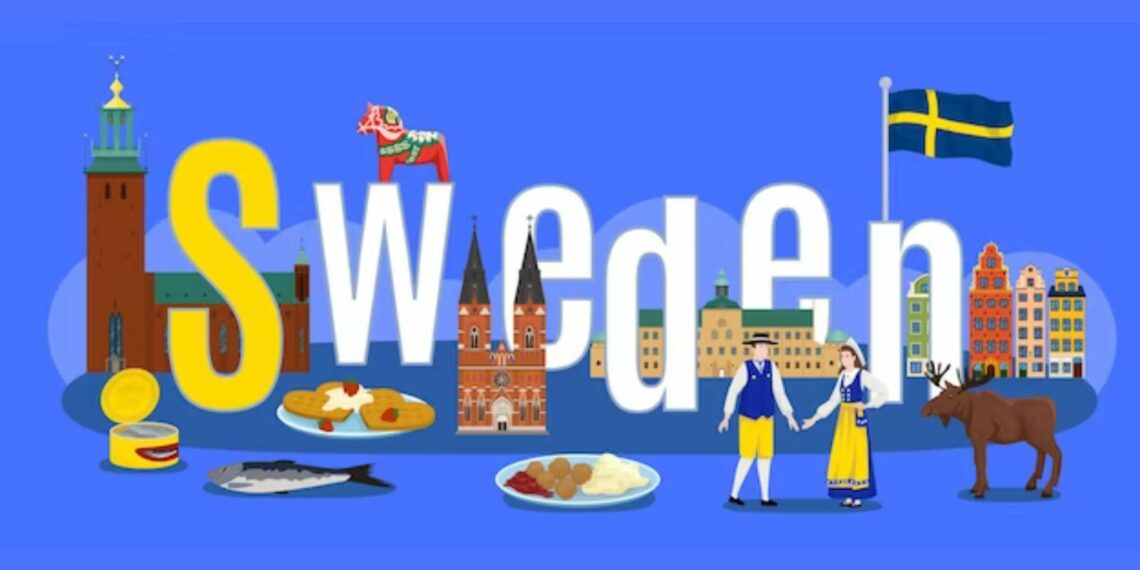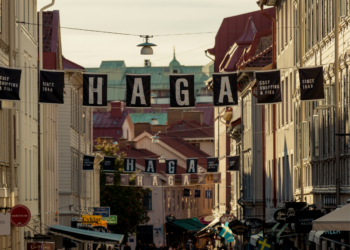Flags have long served as powerful symbols of identity, pride, and unity for nations around the world. The Swedish flag, with its simple yet striking design of a golden Scandinavian cross on a field of blue, is no exception. This iconic flag has a rich history and plays a significant role in Sweden’s cultural and national identity.
In this article, we will delve into the captivating story of the flag of Sweden. Will also explore its origins, significance, and the deep-rooted emotions it stirs in the hearts of the Swedish people.
Understanding the Basics
Before we delve into the intricacies of the Sweden flag, let’s start with the fundamentals. The flag, known as the “Svenska flaggan” in Swedish, consists of a simple yet captivating design. A field of deep blue adorned with a bright gold or yellow Nordic cross beautifully captured the essence of Sweden.
The Design
The blue field, also known as the “Nordic blue,” symbolizes the country’s numerous lakes and water bodies. The gold or yellow cross represents Sweden’s wealth and prosperity.
This timeless design has remained virtually unchanged for centuries, reflecting the nation’s commitment to its heritage.
A Symbol of Peace and Neutrality
One of the most remarkable aspects of the Sweden flag is its association with peace and neutrality. Sweden has a long history of staying out of conflicts and wars, earning a reputation as a peaceful nation.
The flag serves as a powerful reminder of Sweden’s dedication to maintaining peaceful relations with other countries.

Origins of the Swedish Flag
In the early 12th century, there’s a story that says King Eric IX of Sweden saw a golden cross in the sky when he arrived in Finland during the First Swedish Crusade in 1157. He thought it was a sign from God, so he decided to use a banner with a golden cross on a blue background.
Some people think this legend was created to compete with a similar story about the Danish flag, which was recorded in the 16th century.
According to this theory, Sweden’s flag was actually made during the reign of King Charles VIII in 1442. This flag has a blue background divided into four parts by a golden cross. It’s a combination of King Albert’s coat of arms from 1364 and King Magnus III’s coat of arms from 1275.
However, there’s a different view among historians. They believe that Sweden’s flag was blue with a white cross before 1420 and only became blue with a golden cross during the early rule of King Gustav I. King Gustav I took the throne after deposing King Christian II in 1521.
So, there’s some debate about when exactly Sweden’s flag with a golden cross on a blue background was first used, with some thinking it dates back to King Eric IX and others believing it was introduced by King Gustav I.
Over the centuries, the design evolved, and the golden cross eventually became a distinct feature of the Swedish flag.

The Swedish War Flag
While the standard Sweden flag embodies peace and neutrality, there is another version of the Flag of Sweden, and that is the Swedish War Flag.
This flag features a captivating variation of the Nordic cross, with a red border added to the gold or yellow cross on the blue field. The Swedish War Flag symbolizes the country’s readiness to defend its sovereignty if necessary. It also showcases the resilience of the Swedish spirit.
Symbols of Sweden
Beyond its role as a national flag, the blue and gold colors of Sweden’s flag have become iconic symbols of the country itself.
These colors are commonly associated with Sweden, and you can find them adorning a wide range of products and logos. The simple yet elegant design of the flag lends itself well to branding and marketing, making it a powerful symbol for Swedish companies both at home and abroad.
Other than “Svenska flaggan,” another symbol that contributes to the symbols of Sweden is “Tre Kronor” or you can say “Three Crowns.”
Tre Konnor or Three Crowns
The Tre Kronor, or Three Crowns, is the national emblem and an iconic symbol deeply rooted in Sweden’s history and cultural identity. These three golden crowns, arranged in a vertical line within the blue field of the Swedish flag, represent a rich tapestry of historical significance.
Initially associated with the Kalmar Union, a medieval union that united Sweden, Norway, and Denmark, the Three Crowns symbolize Sweden’s historical ties to its Scandinavian neighbors. After gaining independence in 1523, the crowns became a powerful emblem of Swedish sovereignty and national pride.
Beyond their historical connotations, the Three Crowns also represent Sweden’s three traditional regions: Sweden itself, Gothenland, and Svealand. This symbolism underscores the importance of unity among diverse regions within the nation.
Today, the Tre Kronor remains a cherished symbol, evoking a sense of heritage, unity, and national identity among the people of Sweden.
Swedish Logo and Branding
Sweden has a strong presence on the global stage, known for its innovative companies, quality products, and commitment to sustainability and social responsibility.
Many Swedish brands and big companies incorporate the colors of the flag into their logos and marketing materials to showcase their Swedish identity and values.
From Volvo’s blue and gold emblem to IKEA’s distinctive yellow and blue signage, these symbols are instantly recognizable and associated with Swedish excellence.

Significance and National Pride
The Swedish flag holds immense significance for the people of Sweden and is a source of national pride. It is a representation of the country’s history, values, and unity.
1. National Identity
The flag plays a pivotal role in shaping and reinforcing Sweden’s national identity. It serves as a powerful reminder of the shared history, values, and culture that unite the Swedish people.
The flag embodies a deep sense of belonging, fostering a strong national identity that transcends regional differences and backgrounds. It symbolizes the collective identity of the Swedish nation, reminding its citizens of their common heritage and the principles they hold dear.
Moreover, the flag represents Sweden’s commitment to upholding democratic ideals, social equality, and the rule of law. It shows the core values that define the country’s national identity. It serves as a visual expression of these values, reminding Swedes of the importance of unity, solidarity, and civic responsibility in building and preserving their nation.
In times of challenge or uncertainty, the Swedish flag stands as a unifying symbol, reinforcing the sense of national identity and inspiring citizens to work together for the betterment of their country.
2. International Recognition
The flag enjoys widespread international recognition. Its distinctive blue and gold design is instantly associated with Sweden on the global stage.
Whether it’s at international sporting events, diplomatic gatherings, or cultural exhibitions, the flag proudly represents Sweden’s contributions to the world. It symbolizes the nation’s commitment to peace, innovation, and human rights.
Its presence abroad serves as a reminder of Sweden’s positive global influence, fostering a sense of pride among Swedes and a warm welcome for Sweden’s contributions around the world. The flag transcends borders, embodying a shared sense of belonging that extends beyond national boundaries.
3. Celebration of National Holidays
In Sweden, the flag takes center stage during celebrations and national holidays, creating a vibrant atmosphere filled with patriotism and togetherness. The National Day of Sweden falls on June 6th every year and the flag adorns streets, homes, and public spaces.
This lively display of blue and gold serves as a reminder of shared history and values, bringing communities closer together. It’s not just a decoration but a heartfelt expression of love for Sweden, making these occasions even more special.
Whether you’re dancing around the Maypole, enjoying a traditional Swedish feast, or having an enchanting Midsummer’s Eve, the flag’s presence adds a touch of national pride to the festivities.

4. Everyday Use
In Sweden, the national flag isn’t reserved just for special occasions. It’s an integral part of everyday life. Walk down any street, and you’ll spot the blue and gold waving proudly outside homes, businesses, and public buildings.
It’s a comforting sight, a constant reminder of our shared history and values. It’s like a friendly nod from your neighbor, saying, “We’re in this together.” Whether it’s on a crisp winter morning or a warm summer evening, the Swedish flag stands tall, a symbol of our enduring spirit and identity. It’s a little piece of home that makes every day feel a bit brighter.
5. International Solidarity
The flag holds a special place when it comes to international solidarity. In times of global crises or when disasters strike elsewhere, Swedes often rally around their flag as a symbol of support and compassion for those affected. It’s a heartfelt reminder that we are all part of a larger world community.
The flag becomes a symbol of empathy, encouraging individuals and the nation as a whole to reach out and help others in need. It’s a powerful statement of our shared humanity and Sweden’s commitment to standing with others in times of adversity.
Do Sweden’s cities have different Flags?
Yes, many cities and municipalities in Sweden have their own distinct flags. These municipal flags serve as symbols of local identity and heritage, and they often incorporate unique designs or symbols that reflect the history, culture, or geography of the respective cities or regions.
Each municipality has the freedom to design its own flag. These flags are typically used for ceremonial and official purposes within the local jurisdiction. Municipal flags are flown at government buildings, town halls, and other important locations within the municipality. They may also be displayed during local festivals, events, and celebrations.
The basic design of the Swedish national flag remains consistent throughout the country. However, the municipal flags provide an opportunity for individual cities and regions to express their unique character and history. As a result, there is a diverse array of municipal flags throughout Sweden, each with its own symbolism and significance.
Some municipal flags may incorporate elements from the national flag, such as the blue and yellow colors or the Nordic cross design, while others may feature entirely different motifs, symbols, or historical references. These flags play a meaningful role in connecting residents to their local heritage. It also fosters a sense of pride and community within each municipality.
Examples of Swedish cities and regions with their own distinct flags include Stockholm Flag, Gothenburg Flag, Uppsala Flag, and many others. Each of these flags tells a unique story about the place it represents, adding to the rich tapestry of Swedish culture and history.
Final Note
The Swedish flag is more than just a piece of cloth. It is a powerful symbol of Sweden’s history, culture, and identity. Its striking blue and gold design has deep-rooted historical significance, and its role as a symbol of unity and pride continues to be relevant in contemporary Sweden.
Whether displayed during national celebrations, incorporated into brand logos, or used to express solidarity in times of need, the flag of Sweden remains a cherished emblem that represents the essence of Sweden and its people. It is a symbol that unites Swedes across generations and connects them to their rich heritage.









